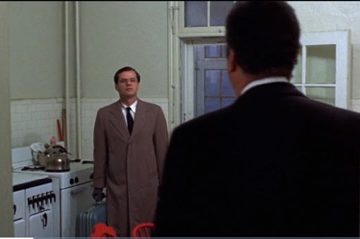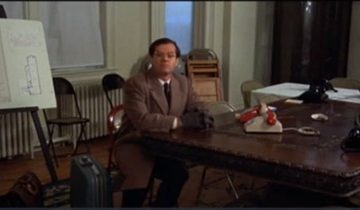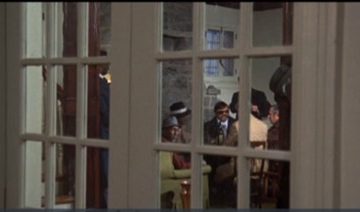In the opening sequence of King of Marvin Gardens when we are first introduced to graveyard shift talk-radio host David Staebler (Jack Nicholson) he seems a man very much in control. He fills the frame and is shrouded in darkness; our eyes are drawn to even his slightest movement. Yet mere minutes later, the illusion is destroyed: Staebler leaves the confines of the radio station and is immediately dwarfed by an urban sprawl of concrete and glass. He returns home to have the airtime tale of his grandfather’s untimely demise rebuffed by the man himself. An initial moment of stability and order (perhaps expected in relation to a white, male, and by all appearances lower-middle class ‘artist-professional’ character) quickly gives way to a film that places Staebler in alien environments, observed from afar with mild amusement by those who appear to be truly pulling the strings.

This sequence under analysis here is the moment where our vision of Staebler as the master of his own narrative is well and truly shattered. We begin on a bus, and Staebler is rendered a literal passenger, no longer dominating the frame, swaddled in brown, passively gazing off screen as he travels to meet a man he doesn’t know on the request of a brother to whom he hasn’t spoken in years. On entering the house at which he intends to meet Lewis – a man, he is informed by his brother Jason, who possesses a great deal of sway with local officials –Staebler’s lack of agency is hammered home. This shot of Staebler hemmed into a decrepit kitchen (fig.1) is a near complete reversal of the film’s opening. There is no air of mystery, no shadow partially obscuring his face, no rapturous close-ups of every adjustment of his glasses. Here, he stands in mid-shot, starkly lit in an off-white kitchen, dwarfed by a member of Lewis’ cohort, a nameless man who nonchalantly fills as much of the frame of as did Staebler’s face in the opening scene.

Having been escorted further into the house and informed to wait, Staebler finds himself in a microcosm of the film’s primary setting: Atlantic City (fig. 2). John Patterson describes the Atlantic City as “the anteroom to Paradise […] a crumbling pleasure dome […] dilapidated, devalued, degraded”. The post-vacation-hotspot but pre-gambling-legalisation era of Atlantic City is presented throughout as a sort of alien, reality-adjacent dystopia of fading greatness sparsely populated by retirees on Zimmer frames, a place where ageing grandeur mingles awkwardly with the everyday as its inhabitants sit waiting for their payday. And here is Staebler, waiting for a man of great significance to bail out his brother, sitting in a fold up chair at a conspicuously grandiose table littered with a bizarre and unexplained array of telephones. It’s Atlantic City in miniature: ageing glory paired with the modern and the temporary, what Patterson calls “the last gasp of an America that is visibly dying all around him”. Indeed, the table acts as a symbol for the unknown and criss-crossing machinations of the city’s criminal underbelly, here represented by the phones littered across its surface. Staebler’s discomfort is visible, his rearranging of the mismatched receivers of the red and white phones constitute a futile attempt to impose control upon an alien environment.

Then we see Lewis – though at this point in the film neither the audience nor David are explicitly told Lewis is who we are seeing (fig. 3). The angle and positioning of the camera implies that we are watching Lewis from David’s point of view, although it might be more apt to say that Lewis – partially obscured by a chair and a door frame, set at the head of a group – is doing most of the watching. The literal and metaphorical distance between the two is palpable, with Lewis taking up a tiny chunk of the frame and the men around him concealed by a door frame that provides yet another barrier between our protagonist and the person he is tasked with approaching. Graham Fuller describes Marvin Gardens as a “ballet of futility”, a film in which many of its main characters dream of that which is forever destined to be out of reach. In Staebler’s case, he is merely trying to get by – his agency is quickly stripped away, a bewildered bastion of the American middle class attempting to come to terms with a world where such grounded and normalised stations appear to no longer exist.
References
Fuller, Graham. The King of Marvin Gardens – Melancholy Meets Irrational Optimism in Bob Rafelson’s New Hollywood Classic. theartsdesk.com. 22 May 2013. Web. 19 Jun. 2018.
Patterson, Jon . The King of Marvin Gardens Shows The Last Gasp of a Crumbling America. 19 May 2013. Web. 19 Jun. 2018.

Dominic Mill is a BA Hons English and Film student at QMUL. Having previously worked as UK editor of We Got This Covered and co-host of The Daily Buzz on KCPW, he intends to split his future endeavours between film, theatre and music.
Please obtain permission before redistributing. Copyright © 2018 Dominic Mill